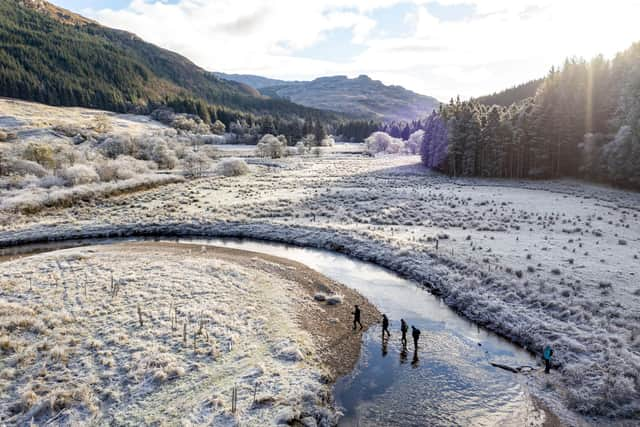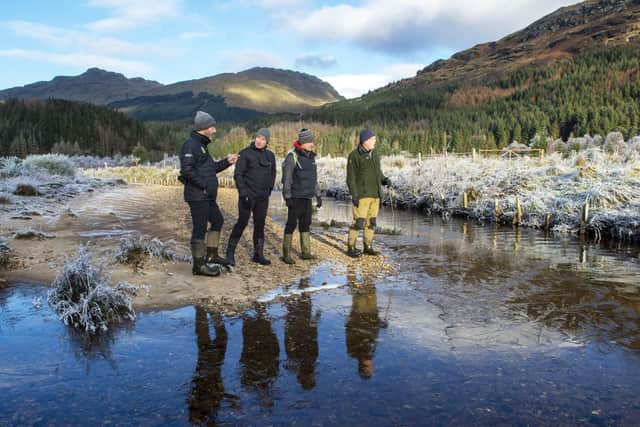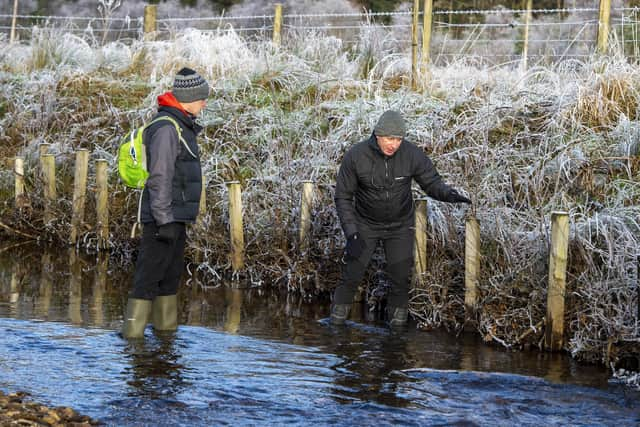The remote Scottish community fighting to save iconic wild salmon
Residents of Lochgoilhead – a village on the Cowal peninsula in Argyll and Bute and within Loch Lomond and Trossachs National Park (LLTNP) – had been growing increasingly concerned over the impacts of climate change and disappearance of wildlife in their area.
So they came together to take action. Working in partnership with the national park authority and Argyll Fisheries Trusts, they have spearheaded a raft of measures aimed at restoring nature and reversing the loss of species.
Advertisement
Hide AdAdvertisement
Hide AdA focus of their work has been the River Goil, an important spawning ground for endangered Atlantic salmon. In recent years the waterway has become increasingly a less favourable habitat for wild fish and the insects they feed on due to collapse of river banks, erosion and other impacts of the warming climate.
Salmon eggs, juvenile fish and most of the invertebrates they eat require cool, clean, well-oxygenated water and silt-free gravel to survive. But erosion leads to an increase in silt levels in the river eco-system, which damages crucial spawning sites and causes excess debris to be dumped into Loch Goil.
A programme of habitat improvements has now been delivered, including planting hundreds of native trees. This should help reduce erosion of the river banks, improve biodiversity and provide shade to help regulate river temperatures.
Natural ‘green revetments’ have also been deployed to further stabilise the river banks. This involved using wooden stakes to pin compacted tree branches against the banks to absorb silt and dissipate the destructive energy of water during flood conditions.
Despite the small size of the Lochgoilhead community, which is home to just 420 people, their efforts are already paying big dividends.


Only three salmon and sea trout nests, known as redds, were found in the river during a count in 2018 – a sure sign the local population was on the brink of vanishing.
The latest survey, carried out in December, identified 15 redds – a five-fold increase in four years. And perhaps most importantly, the nests were more widely spread throughout the eco-system than before.
The results are very encouraging, according to the team, although the full benefits of the habitat improvement projects may not be realised for a number of years.
Advertisement
Hide AdAdvertisement
Hide AdTim King has lived in Lochgoilhead for nine years and is chair of Lochgoil Community Trust.


“Lochgoilhead is a stunning location within the national park and local people want to protect that,” he said. “There is significant interest in environmental matters, especially from our young people, and we are acutely aware of the need to take action on climate and nature.
“Previous projects have included investment in a community hydro scheme, providing a reliable source of income for the community, and creation of an all-abilities path to allow people to access the River Goil and experience their local environment and wildlife.”
M King said he is delighted the work is showing improvements for the long-term health and biodiversity of the River Goil area.
He said: “We are already seeing an increase in the number of kingfishers, otters and other wildlife along the riverbanks. As for wild fish, we are seeing redds – the nests the fish create in the riverbed to lay their eggs – in areas we simply didn’t have them before.


“We expect numbers of these important threatened fish to continue to rise in coming years. Every little bit we do to help has an impact.”
Alongside action to reduce carbon emissions, the national park authority is increasingly prioritising nature restoration and sees support for communities within the park as crucial to delivering this.
Simon Jones, director of environment at the LLTNP Authority, said: “There is growing understanding that we are facing not only a climate crisis, but also a nature crisis, with biodiversity declining faster than at any time in human history.
Advertisement
Hide AdAdvertisement
Hide Ad“The success of the river restoration work in Lochgoilhead shows how, with the right support and funding, a community can take action that has real impact on their local environment and contribute to tackling the twin crises of climate change and biodiversity loss.
“Our Future Nature programme seeks to work with others to restore biodiversity and the natural environment across the national park, creating a resilient, nature-rich national park where abundant wildlife and a healthy natural environment provide a wealth of benefits for both people and nature.
“Bold action is now required and empowering our local communities, businesses and residents will be crucial to delivering that nature-rich national park.”
Scottish rivers are home to around 90 per cent of all wild Atlantic salmon in the UK. But studies suggest only five out of every 100 that set off on their journey to the ocean ever come back.
Numbers have been dropping so steeply experts fear the king of fish may vanish entirely. If declines continue at the existing rate, it is estimated the species will be on the endangered list in less than ten years.
Official figures show the numbers of wild salmon returning to Scotland have declined by around 40 per cent over the past four decades, impacting the conservation status of many rivers in the country.
A number of factors have been blamed for the declines, including attacks from predators, over-fishing, pollution, man-made barriers in rivers, fish-farming and the effects of climate change – such as vanishing food supplies, warming water temperatures and increasingly severe weather conditions.
Comments
Want to join the conversation? Please or to comment on this article.